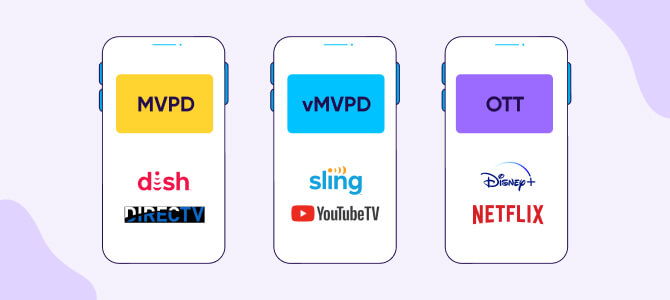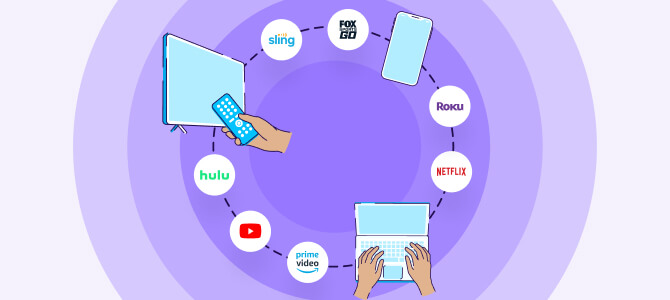
vMVPD (Virtual Multichannel Video Programming Distributor)

A vMVPD (virtual Multichannel Video Programming Distributor) is a service that helps users watch their favorite TV channels through the internet, without cable connections. Besides smart TVs, vMVPD services are accessible on smartphones, tablets, and computers.
What is vMVPD?
It’s an OTT platform, which means it delivers TV channels through your existing internet connection without a traditional TV set-up.
Typically, a vMVPD aggregates content from different broadcast TV channels, so viewers get a vast selection of channels, from ESPN and BBC to National Geographic and Nickelodeon — all without a cable TV connection.
Modern vMVPDs also let viewers watch on-demand video content like films. And they provide other features, such as a programming guide and unlimited DVR (Digital video recorder), to simulate the traditional TV-watching experience.
Just like cable TV services, vMVPDs charge a recurring (usually monthly) subscription fee from viewers.
vMVPD vs. MVPD – What’s different about it?

Traditional MVPDs require viewers to watch content on their TV sets, using a set-top box or other hardware.
With vMVPD, there are no installation hassles. Smart TV users can directly select a vMVPD service or install a streaming device, such as Roku or Amazon Fire TV Stick, to get started. Most vMVPD services also provide apps for Android and iOS devices, which allow viewers to stream TV channels on their phones and tablets.
As a provider, you don’t have to worry about installing extensive infrastructure to reach viewers. All you have to do is build the necessary apps and license and aggregate content from different broadcasters.
The rise of vMVPD platforms
While vMVPD platforms have existed since 2011 (check out Philo), it wasn’t until the launch of Sling in 2015 that they started gaining momentum, and their popularity has soared in recent years: subscriptions in the US crossed 14.2 million in 2021.
Launched in 2017, Hulu + Live TV has the highest market share among prominent vMVPDs, attracting over 4 million subscribers in the US.
Then there’s YouTube TV, one of the fastest-growing vMVPDs with a 30% market share. The platform provides access to more than 85 channels across different niches, including ESPN, MSNBC, CNN, TNT, Comedy Central, and ABC.
Other vMVPD platforms include:
- fuboTV
- DirectTV Now
- Pluto TV
Most of them offer a seven-day free trial or a slew of discounts for the first few months to attract new users, and their subscription fees are significantly lower than those of traditional cable TV operators.
Advantages of vMVPD

vMVPD platforms offer plenty of benefits to OTT service providers and viewers. Let’s take a look at some of them.
Better for viewers
vMVPDs are ideal for people who want to retain the feeling of watching traditional TV, as they can enjoy watching the channels they know and love without paying hefty subscription fees.
Moreover, vMVPD platforms offer “skinny bundles”, i.e., packages of fewer than 100 TV channels, at a lower price than cable TV operators – so viewers aren’t paying over the odds for channels they don’t need.
Also, there are no multi-year contracts or sky-high setup costs, making vMVPD a more affordable option for many households.
Better for you
The enhanced yet familiar experience of vMVPD helps you attract new users. With demand for vMVPD services continuing to grow, adding this offering to your OTT app will let you cater to a growing demographic and diversify your clientele, boosting your earning potential.
Easy to get started
With vMVPD, you don’t have to install any complex infrastructure to deliver your content. All you need to do is create an app that runs on different devices and operating systems.
Similarly, you don’t have to worry about regularly updating your content library with new content. Instead, you can strike deals with different broadcasters and add their channels to your platform, which makes it easier and more cost-effective to start your vMVPD service.
Disadvantages of vMVPD
vMVPD services have many advantages, but there are challenges too.
The exponential rise of vMVPDs will result in stiff competition in the future.
Established platforms like YouTube TV and Hulu + Live TV will leave no stone unturned to dominate the market, making it difficult for new players to build a significant user base.
Moreover, the vMVPD landscape is still evolving, making it difficult for new publishers to identify the right technology and monetization models for their platforms.
vMVPD vs. SVOD
Netflix and Disney+ are examples of Subscription Video on Demand (SVOD) services.
There are similarities with vMVPD, as both models give users unlimited access to content in exchange for a regular subscription fee.
The main difference between the two is that SVOD platforms typically don’t stream content directly from other TV channels.

Is vMVPD the right model for you?
Launching a vMVPD platform offers several benefits, including a diversified user base and more revenue opportunities. But it isn’t the right choice for everyone.
Here are some things to think about if you’re contemplating starting a vMVPD service:
Target audience
vMVPDs are more popular among millennials (particularly those who live with kids). The vast array of content available on these platforms means viewers don’t have to manage multiple TV subscription services, so consider exploring other video-on-demand models if your target audience doesn’t include them.
Technology
Building a vMVPD platform requires a reliable technology provider who understands the intricacies of delivering live, linear, and on-demand content.
You’ll also need a data analytics solution to evaluate content performance and understand user behavior. So, make sure you have access to the necessary technology before getting started.
Pricing
We’ve seen that vMVPD services can be much cheaper than a cable subscription. But users can still pay over $50 a month for vMVPD, whereas some SVOD subscriptions (like Netflix) can cost as little as $7.99 per month.
Delve deeper into your target demographic and understand whether they’ll be willing to pay that kind of money.
If that isn’t the case, you can offer skinny bundles (80-100 channels) at lower prices to attract users.
Key takeaways
- Virtual multichannel video programming distributors (vMVPDs) let viewers stream TV content over the internet in exchange for a monthly subscription fee. Popular vMVPD platforms include YouTube TV, Philo, Sling, fuboTV, and Hulu + Live TV.
- vMVPD services have become popular among cord-cutters who still want to enjoy the experience of watching TV but don’t want its expenses and restrictions. Viewers can watch on a smart TV or via an app.
- Launching a vMVPD service can help you attract a new user demographic and boost your revenue.
- Make sure you consider your target audience well before launching your vMVPD platform and ensure you’ve got the right tech stack too.



